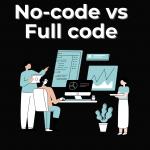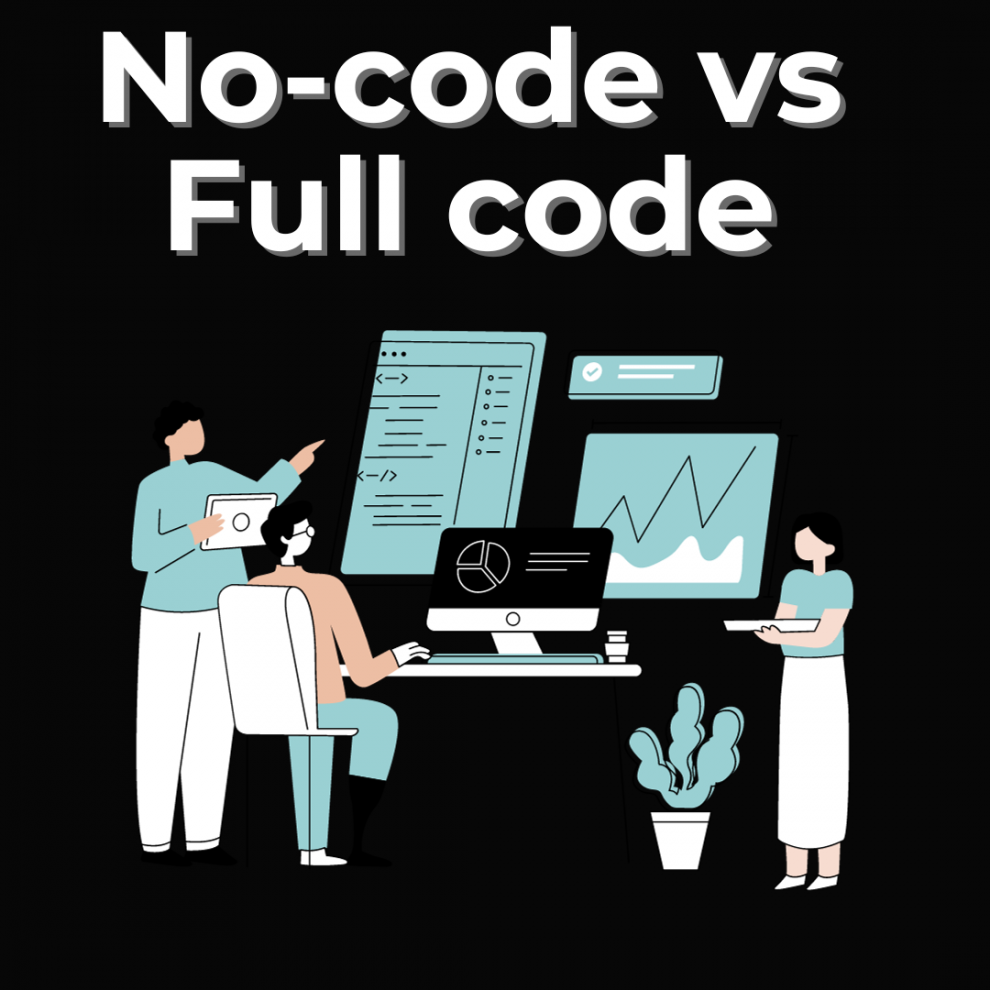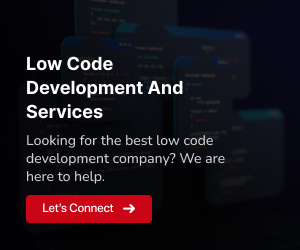In the ever-changing realm of software development, the No-Code vs. full-code debate is no longer a simple choice between simplicity and control. As 2023 unfolds, businesses and developers are faced with a complex decision-making process that goes beyond the surface. This comprehensive analysis aims to unravel the intricacies of both approaches, exploring their evolution, strengths, limitations, and real-world implications in a tech landscape defined by innovation and versatility.
The Evolution of No-Code and Full Code Development
No-Code: Empowering the Non-Technical
No-code platforms have emerged as revolutionary tools, empowering individuals with little to no coding background to create functional applications. In the past, app development was a realm exclusively dominated by programmers fluent in languages like JavaScript, Python, or Java. However, the rise of No-Code platforms democratized this process. Intuitive interfaces, drag-and-drop elements, and pre-built components became the building blocks of applications. As the world transitioned into 2023, these platforms have evolved significantly.
Advancements in No-Code Development
- Artificial Intelligence Integration: No-Code platforms now incorporate AI components, enabling users to add smart features without understanding complex algorithms.
- Mobile-First Development: With the mobile market booming, No-Code platforms have adapted to prioritize mobile application development, offering templates and modules optimized for various devices.
- Cross-Platform Compatibility: No-Code tools have embraced cross-platform development, allowing applications to seamlessly run on different operating systems, ensuring broader reach and user accessibility.
Full Code: Unmatched Customization and Control
Full Code development, rooted in programming languages, offers unparalleled customization and control. Skilled developers leverage their expertise to build applications from scratch, tailoring every element to meet specific requirements. In 2023, Full Code development continues to be the bedrock of intricate and mission-critical applications.
Innovations in Full Code Development
- Blockchain Integration: Full Code developers are integrating blockchain technology into various applications, enhancing security, transparency, and data integrity.
- Quantum Computing Explorations: With the advent of quantum computing, Full Code developers are at the forefront of exploring its potential applications, from cryptography to complex simulations.
- Immersive Technologies: Full Code enables the creation of immersive technologies, including augmented reality (AR) and virtual reality (VR) applications, revolutionizing industries like gaming, education, and healthcare.
Comparative Analysis: No-Code vs Full Code
1. Speed and Efficiency
No-Code:
No-code platforms excel in speed, allowing businesses to conceptualize, develop, and deploy applications within days or even hours. Rapid prototyping becomes a reality, enabling swift iterations and reducing time-to-market significantly.
Full Code:
While Full Code development offers flexibility, it often demands more time due to the meticulous nature of coding. Developers need to write, test, and debug every line, which can extend the development cycle, especially for complex projects.
In 2023, businesses with time-sensitive projects tend to opt for No-Code solutions, ensuring quick deployment and immediate user engagement.
2. Customization and Flexibility
No-Code:
No-code platforms offer a wide array of templates and components. While customization is possible, it might be limited concerning complex functionalities or unique design requirements. Off-the-shelf solutions might not suffice for highly specialized projects.
Full Code:
Full Code development provides limitless customization. Developers can craft every aspect of the application, accommodating intricate features, specific user experiences, and unique design elements. This approach is unparalleled when it comes to tailoring solutions for specific industries or niche markets.
Businesses aiming for highly personalized applications or specialized features often lean towards Full Code development, ensuring their unique requirements are met.
3. Learning Curve and Accessibility
No-Code:
The primary allure of No-Code platforms is their accessibility. Individuals with minimal technical knowledge can grasp the basics swiftly. The intuitive drag-and-drop interfaces eliminate the need for in-depth coding expertise, and democratizing app development.
Full Code:
Mastering Full Code development, on the other hand, requires significant learning and practice. Proficiency in programming languages, algorithms, and problem-solving skills is essential. While there are extensive resources and coding boot camps available, the learning curve remains steep.
Entrepreneurs, small businesses, and non-tech-savvy users often find No-Code platforms empowering and approachable, allowing them to bring their ideas to life without extensive learning curves.
4. Scalability and Complexity
No-Code:
No-code platforms can handle moderate to semi-complex applications effectively. However, when it comes to highly scalable solutions requiring intricate integrations, extensive data processing, or real-time analytics, No-Code tools might hit their limitations.
Full Code:
Full Code development provides the scalability required for applications with high user loads and complex functionalities. Developers can optimize performance, implement efficient algorithms, and integrate seamlessly with various systems, ensuring smooth operations even as the user base grows.
Enterprises and startups anticipating rapid growth or dealing with complex data processing often opt for Full Code solutions, ensuring their applications can scale without compromising performance.
5. Maintenance and Future Updates
No-Code:
No-code platforms typically handle maintenance and updates seamlessly. Since these platforms operate on standardized templates and components, updates are often automatic, ensuring security patches, bug fixes, and new features are readily available without user intervention.
Full Code:
Full Code applications require meticulous maintenance, especially when updates involve changes in external APIs, security protocols, or compliance regulations. While developers have complete control over every aspect, it also means manual intervention for every update, ensuring compatibility.
6. Hybrid Approach: Uniting the Best of Both Worlds
In the dynamic landscape of 2023, a hybrid approach has gained traction, harmonizing the strengths of No-Code and Full-Code development. This innovative strategy acknowledges that neither approach is universally superior; rather, their effectiveness depends on the specific project requirements. Here’s how the hybrid model combines the best of both worlds:
Custom Components with No-Code Foundations:
The hybrid model often begins with a No-Code foundation. Rapid prototyping and basic application structure are created using No-Code platforms. These platforms are excellent for building fundamental user interfaces, handling straightforward workflows, and managing databases.
Full Code for Complex Integrations and Custom Functionalities:
When the project demands intricate integrations, specialized algorithms, or complex data processing, Full Code developers step in. They extend the No-Code foundation by incorporating custom code modules, ensuring seamless integration with APIs, third-party services, and legacy systems. This hybrid approach allows for tailored solutions while capitalizing on the efficiency of No-Code development for simpler components.
Agile Development and Iterative Enhancements:
Hybrid development embraces Agile methodologies, fostering collaboration between No-Code users and Full-Code developers. Continuous feedback loops and iterative enhancements drive the project forward. No-Code users can quickly prototype new features, which are later refined and optimized by Full Code experts, ensuring the application evolves in response to changing requirements.
Scalability and Performance Optimization:
The hybrid approach excels in scalability. No-code platforms handle routine tasks and user interactions, while full-code components optimize performance for high-volume transactions, intricate calculations, and real-time analytics. This division of labour ensures the application scales seamlessly, accommodating growing user bases without compromising speed or stability.
Maintenance and Future-Proofing:
Maintenance becomes a collaborative effort in the hybrid model. No-code platforms simplify routine updates and bug fixes, while full-code developers focus on long-term strategizing. They anticipate future advancements, ensuring the application architecture is robust and adaptable. This proactive approach future-proofs the application, making it resilient to evolving technologies and market demands.
Conclusion: Choosing Wisely in 2023
In the ever-expanding landscape of software development, the choice between no code, Full Code, or a hybrid approach is not a matter of one-size-fits-all. Businesses must assess their unique needs, project scopes, and long-term goals to make an informed decision. No-code platforms offer unmatched speed and accessibility, making them ideal for quick prototypes and straightforward applications. Full Code development provides unparalleled control and customization, catering to complex projects demanding intricate functionalities.
However, the hybrid approach emerges as the epitome of adaptability. By leveraging the strengths of both No-Code and full-code development, businesses can navigate the complexities of modern applications effectively. Collaboration, agility, and a focus on scalability become the guiding principles, ensuring applications not only meet current requirements but also thrive in the face of future challenges.
As 2023 unfolds, businesses embracing this hybrid mindset find themselves at the forefront of innovation, capable of crafting applications that are not just functional, but truly transformative in the digital landscape.





















